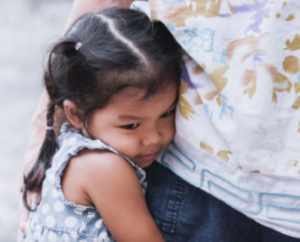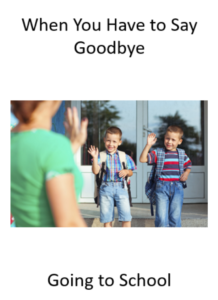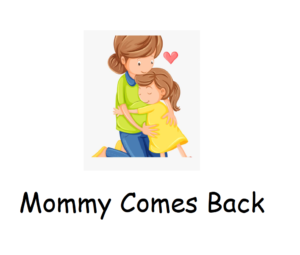
Separation Anxiety, or difficulty with getting your child to allow you to leave them for any period of time, can be one of the most difficult things a parent or caregiver has to deal with. Seeing your child cry, whine, cling, scream or tantrum when you attempt to leave is absolutely heart wrenching, frustrating and anxiety provoking for adults and caregivers. Whether it’s Separation Anxiety when mom leaves to run an errand, or when dad or grandma drops off at day care or school, chances are your child isn’t the only one going through this.
In fact, Separation Anxiety in varying levels of severity is very common with young children and it is seen most frequently with transitions into schools or new environments where parent won’t be there. The first day of a new preschool, or even the first day in a new classroom in the same preschool, can be met with a mix of excitement and anxiety for kids and parents alike. Although it’s fun to embark on a new adventure and many preschoolers delight in the feeling of being “big,” change can be scary for little ones (and their worried parents).
As you prepare to take on the challenge of Separation Anxiety for a return to school, work or otherwise, try these strategies to help prepare your child for what’s coming and help them cope with their emotions:
TIPS FOR HELPING YOUR CHILD WITH SEPARATION ANXIETY:
- MAKE AND PRACTICE A GOODBYE RITUAL– Having a special handshake, goodbye dance/song or special phrase matched with physical touch (think “Ugga Mugga” from Daniel Tiger) gives your child a fun and special way to bond with you before the goodbye. To make this work you will need to involve your child in coming up with ideas for your “special goodbye” and then practice it repeatedly! It’s important to role play the process of saying your “special goodbye” when your child is calm and you aren’t really leaving. This will help prepare your child for a safe and familiar ritual that will keep them positive during the actual goodbye when it happens.
- DO A PRACTICE RUN (OR RUNS)-Prior to the big change and separation (whether it be your child returning to in-person school after distance learning or mom or dad going to work) you want to make sure you are preparing your child with what to expect by doing practice runs before the event happens. For a return to or initial school start, this could mean driving by the school and showing your child where they will walk in, talking about it and answering questions they may have and practicing your goodbye ritual there at the school. Or prior to parent leaving back to work away from home, start to practice your goodbye ritual 3 days before it actually happens. Have parent leave the house for small increments of time (5 mins, then 10 mins), and then come back to ensure the child understands that even when a parent leaves, they will always come back. Doing practice runs helps prepare your child for what to expect while also letting them practice self-soothing and the goodbye ritual in a positive and low-stakes setting.
- READ ABOUT IT-Using Scripted Stories like the ones below can be a great way to teach your child about what to expect and what they can do when they start to feel upset or anxious. Check out some of these options below and remember the earlier and more you read them with your child, the better they will be able to understand and feel prepared for the separation. (see more stories in English and Spanish under the Visual Resources tab and then click Scripted Stories)
- STICK TO A ROUTINE-Children are creatures of habit and often find a sense of security in structure and consistent routines. By ensuring you have a strict routine that isn’t rushed or chaotic, you will really help keep your child calm prior to the separation. So, whether it’s making sure everyone is up early to allow enough time to get ready or doing the morning routines in the same order every time (i.e. wake up, brush teeth, get dressed, eat breakfast then get in the car or do the goodbye ritual), these routines will ensure you are setting the stage for a smooth transition to the separation.
- PACK A TRANSITIONAL OBJECT-If possible, having your child take a security item that stays with them before and after the separation can really help them with emotional regulation and helps maintain a sense of normalcy and security during what often can be a stressful time for them during transitions. Transition items may include a small picture of a loved one, or small item given to them by a loved one (like a key chain or bracelet). Giving the child something they can hold or look at to bring them comfort when they have to separate can be a great way to help ease the sadness or anxiety they feel when their loved one leaves.
- SHOW EXCITEMENT-Instead of only focusing on the separation, be a super cheerleader and HYPE UP all the fun things they will be doing while you are away. Be enthusiastic about the activities and also about how excited you will be to hear them talk about what they got to do when you return. Kids totally pick up on adult energy and emotions, so if you are truly excited and show it, they will start to internalize that and show excitement as well.
- VALIDATE FEELINGS-The last thing you should ever do is dismiss your child’s feelings by saying phrases like: “you have no reason to be upset” or “there is no reason to cry/be sad.” When we dismiss our child’s feelings, we are not helping, we are increasing their anxiety and showing them we don’t value their emotions. Instead, VALIDATE. Let them know that it’s okay to feel sad or scared and that sometimes you feel sad or scared too! Sometimes kids just need to feel heard, and know that you understand how they feel, before they can work towards moving past the emotion.
- MODEL SELF-REGULATION STRATEGIES-After you validate their feelings, it is important to SHOW THEM what they can do to help regulate emotions and make them feel better. Whether it is deep breaths, looking at their transition item, or repeating a mantra like “Mommy will come back, and I’m going to have so much fun until she does,” teaching your child what they can do to help regulate their emotions is best done by you MODELING how to do it. So instead of just telling them to take a deep breath, SHOW THEM, narrate or talk through when you feel upset and what you do to calm down. Kids learn through our actions, so the more you model and show them how you use Self-Regulation strategies, the more likely they will begin to try and use them as well!

